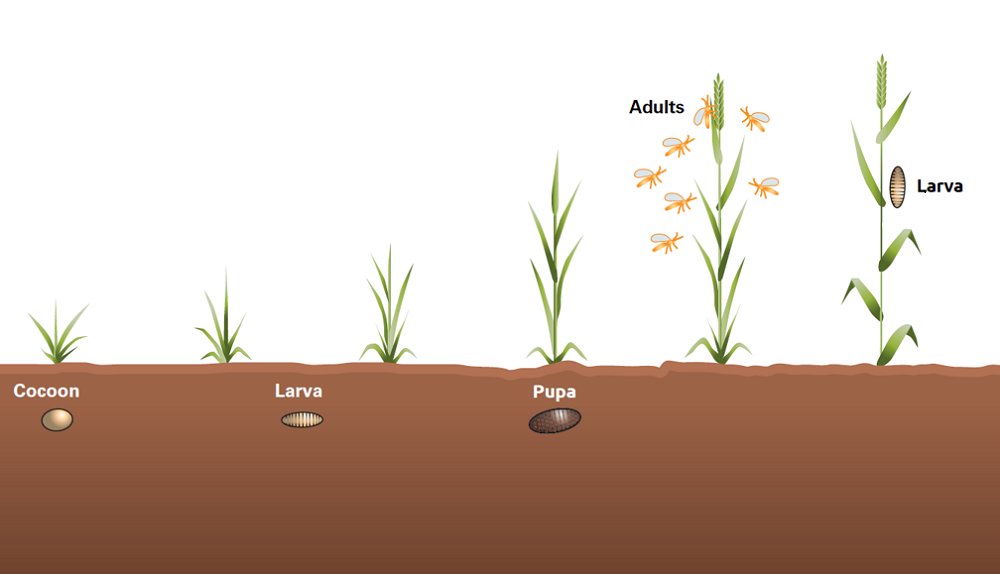- Home
- Knowledge library
- How to identify wheat blossom midges
How to identify wheat blossom midges
When larvae of wheat blossom midges feed on cereal ears, it can reduce pollination, impede grain development, increase fungal attacks, and cause premature sprouting. As symptom severity and timing depends on the midge species, it is important to identify which one is present.
Orange wheat blossom midge (Sitodiplosis mosellana) is the most common and serious species. The less frequently observed yellow/lemon wheat blossom midge (Contarinia tritici) is rarely damaging.
What damage do orange wheat blossom midges cause?
Orange wheat blossom midge larvae feed on developing grains, causing grains to become small and shrivelled. They can also damage the outer grain layer (pericarp), allowing water to enter. This can make the grain vulnerable to fungal infection (e.g. fusarium and septoria) and result in premature sprouting. Seed from infected crops is also associated with poor germination.
Susceptible crops are at the highest risk when adult midge emergence coincides with ear emergence, particularly growth stages 53–59. Larvae that hatch after flowering do not develop properly and cause little damage.
Wheat and rye are particularly susceptible, although barley, oats and triticale may also be affected.
How damaging are wheat lemon blossom midges? (blog)
Orange wheat blossom midges: Identification and life cycle
Larvae can survive in cocoons for over ten years (particularly in the absence of extremely cold winters).
Following a sufficient period of cold, larvae emerge and move to the soil surface. If the soil is warm (over 13°C) and moist, larvae pupate and develop into adult midges. If conditions are unsuitable, larvae return to the cocoon stage.
During late spring, emerging adults – which are orange and about 3 mm long – mate on the soil surface. For flight, the midge prefers still, dry, warm conditions (air temperatures above 15°C – although flight may occur as low as 10°C). Low light conditions are also preferred, so midges tend to fly later in the evening on sunny days.
Adult males have long, feathery antennae. They fly to seek a mate on the first evening after hatching.
Mated females fly on the next five suitable evenings after hatching. They use their short ovipositor to lay cylindrical eggs inside florets of emerging ears, with most laid on the first few evenings of flight.
Larvae hatch within 4–10 days and feed on the developing grain for 2–3 weeks. Usually after rain has moistened the soil surface, larvae drop to the ground, burrow into soil and hibernate within cocoons.
 AHDB
AHDB
How to identify yellow/lemon wheat blossom midges
This midge has a similar life cycle to that of orange wheat blossom midge. However, it is less persistent, with pupation occurring within three years. The larvae are also smaller and more yellow. Although adults emerge at a similar time, they locate crops at earlier growth stages – as the boot splits to reveal the ear. They do not lay eggs in florets, once they are clear of the boot. The larvae feed on the stigma, preventing pollination and development of the grain, and then on the anthers, which are retained within the floret. After feeding for 2–3 weeks, they return to the soil. Some larvae do not form cocoons, but pupate in September, forming a second generation that feeds on couch grass.
How to manage orange wheat blossom midge
Once orange wheat blossom midge larvae reach the ear, sprays are no longer effective. For susceptible cereal varieties, monitoring adult midge activity is a key component of integrated pest management (IPM), with the spray-threshold system built around the number of midges observed.
 and yellow-lemon wheat blossom midge (right). © Jon Oakley.JPG) Jon Oakley
Jon Oakley
Orange wheat blossom midge (left) and yellow/lemon wheat blossom midge (right). © Jon Oakley
 ADAS.JPG) ADAS
ADAS
Orange wheat blossom midge larvae feed on developing grains. (C) ADAS.

